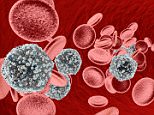Molecular basis of the activation of endothelial cells by anti–β2 glycoprotein I antibodies. This scheme includes those processes described in the literature that have been confirmed in animal models of APS. PP2A, protein phosphatase 2A.
In this issue of Blood, Sacharidou et al characterize all steps involved in the activation of endothelial cells by anti–β2 glycoprotein I autoantibodies.1
The antiphospholipid syndrome (APS) is defined by the presence of so-called antiphospholipid antibodies in plasmas of patients with thrombosis or pregnancy morbidity.2 The name of the syndrome is a misnomer, because we know that the autoantibodies that cause the thrombotic complications are not directed against anionic phospholipids but rather against plasma proteins with high affinity for anionic phospholipids. Many studies have shown that antibodies that recognize an epitope within domain I of β2 glycoprotein I are responsible for the increased thrombotic risk.
Whether this subpopulation of autoantibodies constitutes the only group of circulating pathological antibodies is unclear; however, it is the only one the prothrombotic activity of which has been confirmed in many mouse models for APS.4 The identification of a pathological subpopulation of antiphospholipid autoantibodies was an important step in the identification of patients at high risk for complications, but it immediately raised many additional questions: Which cells are the target of the anti–β2 glycoprotein I antibodies? Which receptors on the cell surface are responsible for the binding of the antibodies? How is this binding translated into a change in phenotypic expression of the cells? What are the important changes induced?

In their report, Sacharidou et al show that apoER2, also called LRP8, on endothelial cells is a major receptor for anti–β2 glycoprotein I antibodies. They determine both in vitro and in vivo the signaling pathway that links apoER2 to inhibition of the synthesis of nitric oxide (NO) synthase (see figure). In doing so, they identify a number of potential therapeutic targets for the treatment of APS.
The studies by Sacharidou et al and others clearly show the important role of endothelial cells in the thrombotic risk induced by anti–β2 glycoprotein I antibodies. Does this exclude the potential role of other cells, such as platelets and monocytes? Probably not, because there are strong indications, not only in in vitro experiments but also in mouse models of APS, that platelets and monocytes are involved in the increased thrombotic risk.5 Moreover, both cells express apoER2 and have the potential to be activated by the antibodies. There could be cooperation between different cells involved in the regulation of hemostasis.
These studies underline again the importance of apoER2 as a receptor for anti–β2 glycoprotein I antibodies.6 Not everyone agrees that apoER2 is the primary receptor for anti–β2 glycoprotein I antibodies, because other cell-surface proteins have been convincingly identified as possible receptors for these antibodies. apoER2 is predominantly expressed in the central nervous system.7 There it functions as a receptor for the neurotransmitter reelin. Interestingly, apoER2 needs a coreceptor for the binding of reelin: the very low–density lipoprotein receptor. A coreceptor is also involved in the binding of the antibodies to platelet apoER2: glycoprotein Ib.
These coreceptors probably facilitate the specificity of the interactions. It is not unlikely that on the surface of endothelial cells, apoER2 also acts in combination with a coreceptor. Toll-like receptors 2 and 4 are possible candidates. It would be of great interest to see whether the presence of additional receptors influences the signal transduction pathway activated.
Sacharidou et al focus on the downregulation of NO synthesis. It has been shown in mouse models that activation of endothelial cells by anti–β2 glycoprotein I antibodies results in more changes in cell metabolism, regulated by the translocation of NF-κB.9 Upregulation of tissue factor expression and downregulation of thrombomodulin could also be involved in the loss of antithrombotic properties of endothelial cells. It is clear that the binding of anti–β2 glycoprotein I antibodies to endothelial cells strongly influences the metabolism of the cells. An important issue is whether this happens continuously when the antibodies circulate or whether it is induced after a trigger as yet unknown.
The experiments in which Sacharidou et al attenuate thrombus formation induced by the antibodies by inhibiting PP2A are interesting. The identification of apoER2 as a receptor for anti–β2 glycoprotein I antibodies did not lead to the identification of possible therapeutic targets, because reelin signaling in the brain is important for brain development, dendritic spine remodeling, and synaptic plasticity.7 apoER2 is obviously not a primary target for treatment.
The signaling pathway underlying apoER2 in the brain is different from the pathway now described for endothelial cells.7 PP2A has not been identified in the brain as an intermediary in apoER2 signaling. As shown by Sacharidou et al, this opens new avenues through which to specifically inhibit apoER2 signaling in endothelial cells. However, we do not know the physiological function of apoER2 signaling in endothelial cells. Additional studies with long-lasting inhibition of PP2A are needed to identify this pathway as a target for prophylactic treatment of patients with APS.



